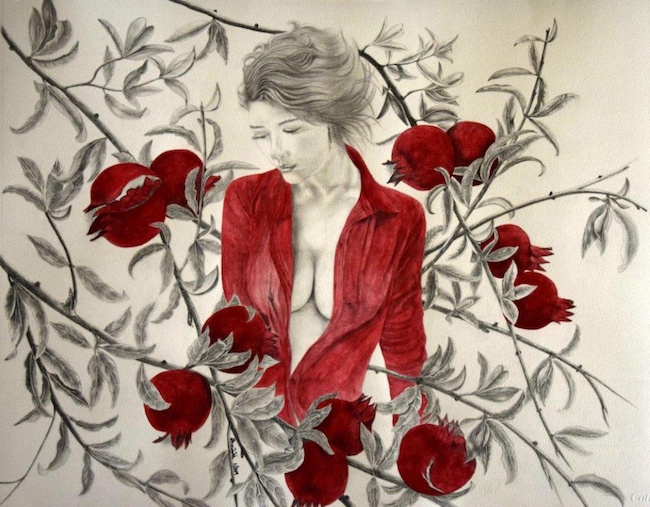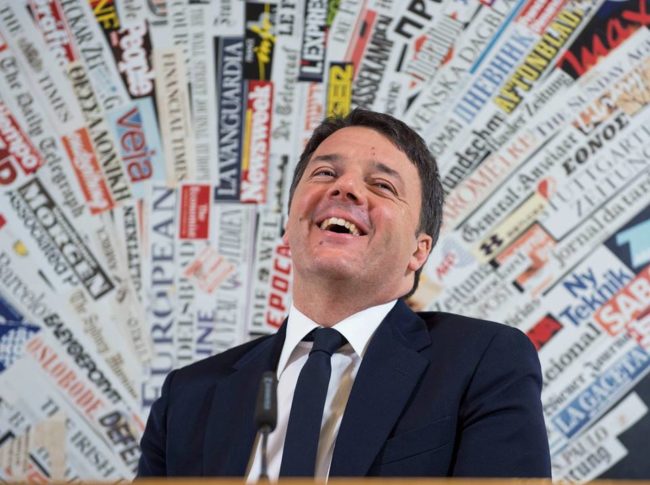Le tecniche artistiche dei secoli passati si sono ampliate nel Ventunesimo secolo e hanno aperto la strada a interazioni inedite, a un approccio innovativo e singolare generato dalla libertà espressiva che contraddistingue l’epoca contemporanea e che è in grado di dar vita a opere dal sapore moderno malgrado l’utilizzo di materiali già noti nell’arte più tradizionale. La protagonista di oggi si avvale del disegno a matita per raccontare il suo punto di vista sulla donna nella contemporaneità, sulle sue fragilità e sulla sua poetica evanescenza che si svela solo a chi sa andare in profondità, oltre un’apparenza diversa.
Il disegno è stato essenziale nel corso dei secoli per la struttura stessa delle opere d’arte, perché l’attinenza alla realtà osservata era fondamentale per raccontare e riprodurre scene di vita oppure ritratti di nobili e aristocratici, ma anche per definire la prospettiva, l’anatomia, la geometria, lo studio della luce e dei colori; a partire dal Seicento però cominciò ad avere uno spazio proprio e molti maestri dell’epoca produssero schizzi che svelarono quanto il disegno fosse non solo la base della pittura ma anche una forma d’arte a se stante e complementare alla tecnica più tradizionalmente riconosciuta e apprezzata dell’olio su tela. Con la scoperta dell’Oriente poi, gli studiosi e gli artisti che si spinsero a visitare e scoprire quel mondo nuovo e affascinante, si resero conto di quanto in quelle culture la tecnica del disegno, in particolare quello a inchiostro, fosse diffusa e considerata alta forma d’arte sia in Cina che in Giappone dove le linee scure e monocrome della china venivano sfumate e completate con colori per riprodurre immagini della natura oppure scene di vita quotidiana. La capacità di far interagire in maniera evidente il disegno divenne una delle linee guida principali dei Fauves prima e degli Espressionisti poi, laddove la linea netta e definita era funzionale a enfatizzare l’intensità e l’irrealtà dei colori che dovevano rappresentare il mondo emotivo, il sentire interiore degli esecutori delle opere. Anche molti esponenti dell’Astrattismo, del Surrealismo e dell’Espressionismo Astratto sottolinearono l’importanza delle linee nette e decise del disegno all’interno delle loro opere per lasciare che la pittura interagisse con la matita o la china, come nella realtà in cui la morbidezza delle tonalità intermedie si accosta necessariamente alla durezza degli eventi che contraddistinguono la vita di ciascuno, o in un mondo ideale in cui le linee divengono simboli di una semplificazione che induce a uscire dalle complicazione della quotidianità e di un mondo emotivo che distoglie dall’essenza della creazione plastica. Negli ultimi anni il Realismo e soprattutto l’Iperrealismo, hanno trovato una propria dimensione nel disegno, che sia esso a inchiostro, a matita, o a penna, svelandone le infinite possibilità e la versatilità che permette a quella forma espressiva di avere una propria collocazione nel mercato dell’arte, oltre che l’apprezzamento di collezionisti e di appassionati. L’artista greca Pappa Fotini usa il disegno a matita per raccontare l’essenza e il mondo interiore complicato della donna attraverso lo sguardo e la capacità empatica tipicamente femminili in grado di osservare ciò che spesso per l’uomo rimane misterioso e celato, perché appartenente a un mondo diverso dal proprio e per questo spesso inaccessibile.

Attraverso la sua sensibilità l’artista evidenzia la necessità della donna di sentirsi libera di essere se stessa, di mostrarsi senza per questo essere giudicata, di lasciare che le sue sensazioni ed emozioni vengano manifestate senza essere utilizzate per ferire quella sensibilità che necessita di trapelare.
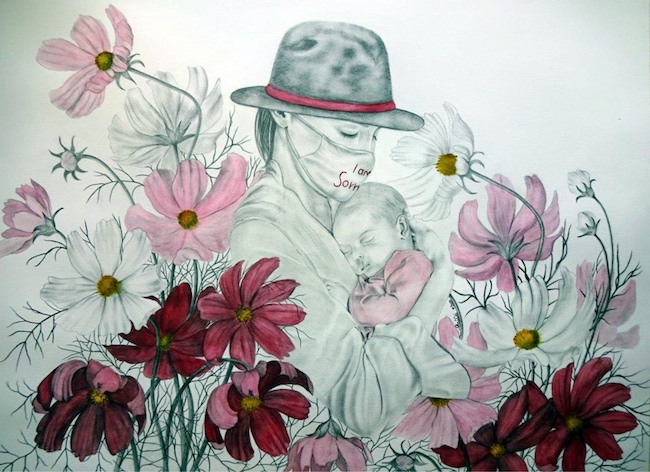
Le protagoniste di Pappa Fotini a volte si mostrano fiere e orgogliose di se stesse, altre invece sembrano riflettere, in altri casi si perdono dentro un ricordo, una sensazione, un timore, un desiderio; il tratto della matita, sfumato e ammorbidito per esprimere tutto quel mondo emotivo svelato sottovoce dall’artista si contrappone all’acquerello rosso, più o meno intenso a seconda delle opere, che diviene complemento essenziale per sottolineare quanto ciò che ruota intorno all’essere umano possa trasformarsi in un dettaglio rilevante per narrare e descrivere la sua personalità, il suo modo di essere e di vivere le emozioni.
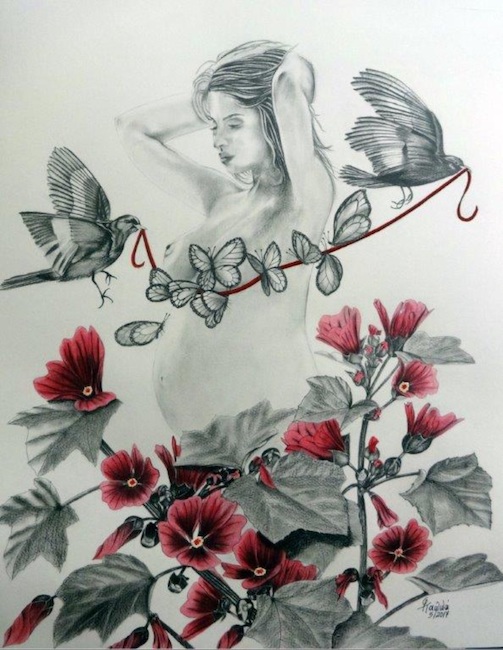
La Fotini sviluppa le sue opere secondo le tematiche che le stanno a cuore e che le sono necessarie per interpretare gli stati d’animo di chi le sta intorno e di cui interpreta le emozioni più profonde ma anche i propri, quel caleidoscopio di sensazioni che attraversano la sua mente e la sua interiorità sulla base degli eventi che si susseguono.
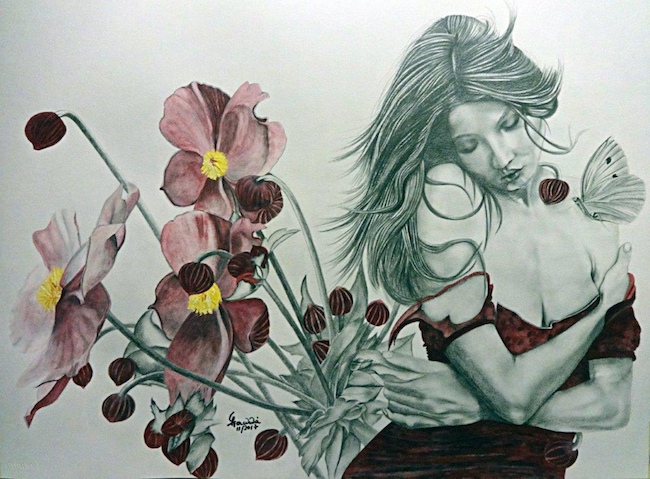
La serie Woman is flower (La donna è un fiore) è stata ideata per dire no alla violenza sulle donne, una presa di posizione necessaria per difendere il diritto del mondo femminile a non essere violato od oggetto di aggressione solo per avere il coraggio di manifestare una propria idea, un proprio punto di vista, il desiderio di libertà e il diritto di compiere una scelta; nel lavoro Hug me (Abbracciami) la protagonista sembra ripiegarsi su se stessa, rassegnata a essere l’unica su cui poter fare affidamento ma al tempo stesso orgogliosa di aver raggiunto la consapevolezza di non aver bisogno di qualcuno di esterno a sé per restare in equilibrio.

In Melody of love (Melodia dell’amore) la Fotini descrive la maternità, quella capacità della donna di donare la vita e di crescere i propri figli prendendosene cura, malgrado gli stessi poi crescendo dimentichino di essere stati abbracciati e coccolati da una donna appartenente allo stesso genere di quella che nel presente maltrattano solo per la propria incapacità di mostrare rispetto e gratitudine, di essere in grado di tenere testa all’indipendenza, alla forza e alla determinazione che contraddistinguono la femminilità contemporanea. Spesso, sembra dire l’artista, il desiderio di libertà, di emancipazione e di autonomia delle donne viene soffocato, soppresso dall’uomo che non si sente sufficientemente forte ed equilibrato per conviverci e dunque utilizza l’unico modo con cui sa di poterla sopraffare, la violenza fisica.
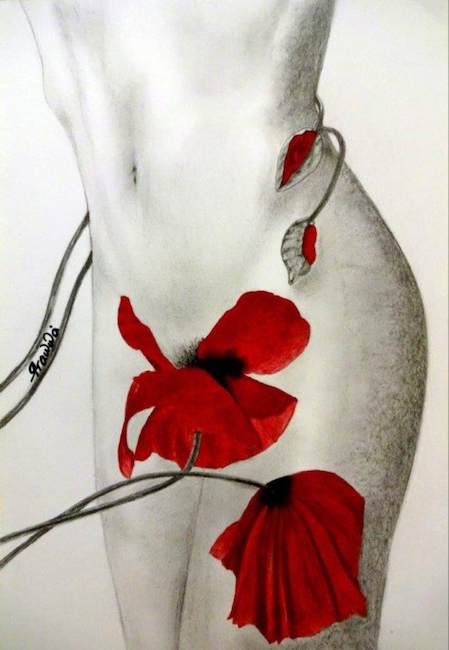
Nella serie Poetry and painting (Poesia e pittura) Pappa Fotini narra il fascino della passione, di quel lasciarsi andare alle sensazioni più intense che fanno parte di un mondo femminile nascosto, non rivelato, spesso messo a tacere ma che non può fare a meno di manifestarsi nell’intimità di un momento privato, nell’attimo di un ricordo, in quella fase di consapevolezza delle proprie emozioni che non può fare a meno di emergere; in Red words (Parole rosse) i papaveri rappresentano la passionalità della donna protagonista dell’opera, quell’ardore che non può fare a meno di essere poetico, in virtù della tendenza femminile a coniugare sempre l’amore fisico con quello emozionale, a trasformare ogni desiderio in moto dell’animo, della tendenza lirica a volersi unire all’altro in maniera totale e completa.
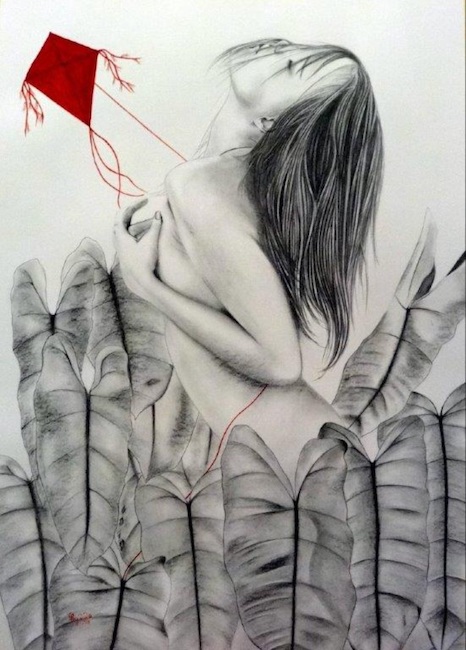
Così come in The last frisk (L’ultimo controllo), Pappa Fotini rappresenta la figura femminile prima che si abbandoni completamente, che insegua quell’aquilone fuori controllo in virtù del quale elevarsi e lasciare il momento terreno per entrare nella dimensione del volo libero. Il tratto realista della matita si alterna a quello intenso del colore rosso dando vita a opere dalla voce intensa e coinvolgente, contraddistinte da una lirica poetica, evanescente ma al tempo stesso fortemente incisive per il messaggio che lasciano all’osservatore. Pappa Fotini trova ispirazione nella poesia e ne diviene di fatto interprete infatti le sue opere hanno illustrato le copertine di quindici raccolte poetiche e di due riviste d’arte; nel corso della sua carriera ha partecipato a circa cento mostre collettive in India, Sicilia, Svizzera, New York, Zurigo, Miami, Roma, Barcellona, Malesia, Romania, Siria e Grecia. Ha all’attivo anche quattro mostre personali in Grecia: a Preveza, Tessaloniky, Kiato e Atene.
PAPPA FOTINI-CONTATTI
Email: tklonis@otenet.gr
Sito web: https://www.alesarte.com/pappa-fotini.php
Facebook: https://www.facebook.com/foteinh.pappa.73
Instagram: https://www.instagram.com/fotinipappa_art/
Pappa Fotini, the art of pencil drawing to describe the poetic delicacy of women
The artistic techniques of past centuries have expanded in the 21st century and opened the way to new interactions, to an innovative and unique approach generated by the expressive freedom that characterises the contemporary age and that is able to give life to artworks with a modern flavour despite the use of materials already known from more traditional art. Today’s protagonist uses pencil drawing to tell her point of view on women in the contemporary world, on their fragility and on their poetic evanescence, which is only revealed to those who know how to go deeper, beyond a different appearance.
Drawing has been essential over the centuries for the very structure of artworks, because its relevance to observed reality was fundamental for narrating and reproducing scenes from life or portraits of nobles and aristocrats, but also for defining perspective, anatomy, geometry, the study of light and colours; from the 17th century onwards, however, it began to have a space of its own, and many masters of the time produced sketches that revealed how drawing was not only the basis of painting but also a form of art in its self and complementary to the more traditionally recognised and appreciated technique of oil on canvas. With the discovery of the East, scholars and artists who went to visit and discover that new and fascinating world realised how widespread the technique of drawing, particularly ink drawing, was in those cultures and how it was considered a high form of art in both China and Japan where the dark, monochrome lines of Indian ink were shaded and completed with colours to reproduce images of nature or scenes from daily life. The ability to make the drawing interact in an evident way became one of the main guidelines of first the Fauves and then the Expressionists, where the sharp, defined line was functional to emphasise the intensity and unreality of the colours that were meant to represent the emotional world, the inner feeling of the artists.
Many exponents of Abstractionism, Surrealism and Abstract Expressionism also emphasised the importance of the sharp, defined lines of drawing within their works to let the paint interact with the pencil or Indian ink, as in reality where the softness of intermediate tones is necessarily juxtaposed with the harshness of the events that mark each person’s life, or in an ideal world where lines become symbols of a simplification that induces one to escape from the complications of everyday life and an emotional world that distracts from the essence of plastic creation. In recent years, Realism and above all Hyperrealism have found their own dimension in drawing, whether in ink, pencil or pen, revealing the infinite possibilities and versatility that allow this form of expression to have its own place in the art market, as well as the appreciation of collectors and art lovers. Greek artist Pappa Fotini uses pencil drawing to tell the story of the essence and complicated inner world of women through the typically female gaze and empathic ability to observe what often remains mysterious and hidden for men, because it belongs to a world different from their own and is therefore often inaccessible. Through her sensitivity, the artist highlights the need for women to feel free to be themselves, to show themselves without being judged, to allow their feelings and emotions to be expressed without being used to hurt the sensitivity that needs to come through. The protagonists of Pappa Fotini sometimes show themselves proud of themselves, others seem to reflect, in other cases they lose themselves in a memory, a sensation, a fear, a desire; The pencil stroke, shaded and softened to express all that emotional world revealed in a whisper by the artist, contrasts with the red watercolour, more or less intense depending on the artwork, which becomes an essential complement to underline how what revolves around the human being can become a relevant detail to narrate and describe his personality, his way of being and living his emotions.
Fotini develops her artworks according to the themes that are close to her heart, that are necessary for her to interpret the moods of those around her and whose deepest emotions she interprets as well as her own, that kaleidoscope of sensations that run through her mind and interiority on the basis of the events that follow one another. The series Woman is flower was created to say no to violence against women, a necessary stance to defend the right of the female world not to be violated or object of aggression just for having the courage to express one’s own idea, one’s own point of view, the desire for freedom and the right to make a choice; in the artwork Hug me the protagonist seems to withdraw into herself, resigned of being the only one she can rely on but at the same time proud of having reached the awareness of not needing someone outside of herself to remain in balance. In Melody of love, Fotini describes motherhood, that capacity of a woman to give life and to raise her children taking care of them, despite the fact that as they grow up they forget that they were embraced and cuddled by a woman belonging to the same gender as the one they mistreat only because of their inability to show respect and gratitude, to be able to stand up to the independence, strength and determination that distinguish contemporary femininity. Often, the artist seems to say, women’s desire for freedom, emancipation and autonomy is stifled, suppressed by men who do not feel strong and balanced enough to live with it and therefore use the only way they know they can overpower them, physical violence. In the series Poetry and painting Pappa Fotini narrates the fascination of passion, of letting oneself go to the most intense sensations that are part of a hidden female world, not revealed, often silenced but that cannot help but manifest itself in the intimacy of a private moment, in the instant of a memory, in that phase of awareness of one’s own emotions that cannot help but emerge; in Red words the poppies represent the passion of the woman protagonist of the work, that ardor that cannot help but be poetic, by virtue of the feminine tendency to always combine physical love with emotional one, to transform every desire into a movement of the soul, of the lyrical tendency to want to unite with the other in a total and complete way.
Just as in The last frisk, Pappa Fotini represents the female figure before she completely abandons herself, chasing that out-of-control kite by virtue of which she can rise and leave the earthly moment to enter the dimension of free flight. The realistic stroke of the pencil alternates with the intense one of the red color giving life to artworks with an intense and involving voice, marked by a poetic lyric, evanescent but at the same time strongly incisive for the message they leave to the observer. Pappa Fotini finds inspiration in poetry and becomes its interpreter, in fact his artworks have illustrated the covers of fifteen poetry collections and two art magazines; during her career she has participated in about one hundred group exhibitions in India, Sicily, Switzerland, New York, Zurich, Miami, Rome, Barcelona, Malaysia, Romania, Syria and Greece. She also had four solo exhibitions in Greece: in Preveza, Tessaloniky, Kiato and Athens.


